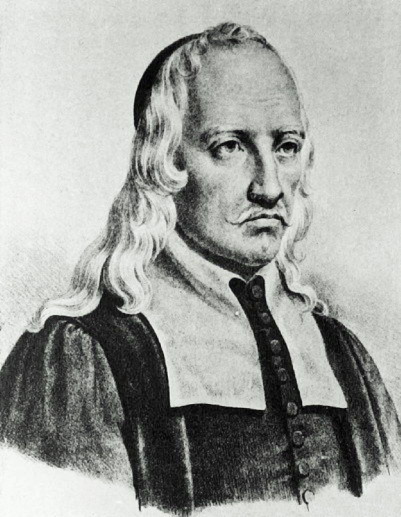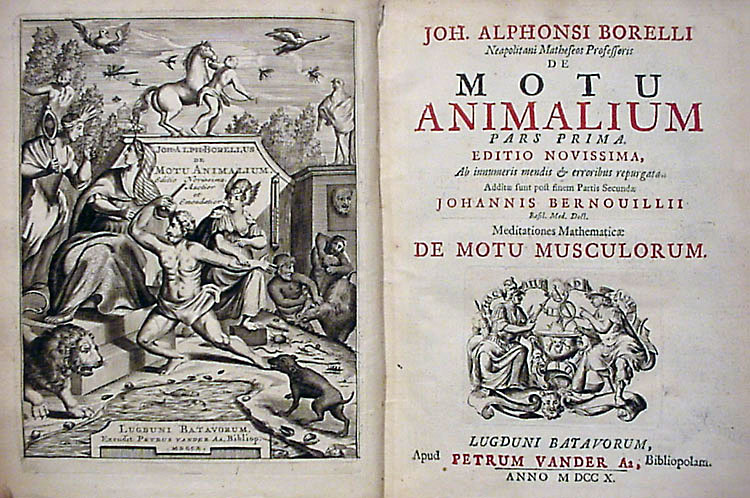
Giovanni Alfonso Borelli (1608 – 1679)
On January 28, 1608, Renaissance Italian physiologist, physicist, and mathematician Giovanni Alfonso Borelli was born. Trained in mathematics, Borelli also made extensive studies of Jupiter’s moons, the mechanics of animal locomotion and, in microscopy, of the constituents of blood. He also used microscopy to investigate the stomatal movement of plants, and undertook studies in medicine and geology.
“No sensible person will deny that the works of Nature are in the highest degree simple, necessary and as economical as possible. Therefore machines devised by mankind will doubtlessly likewise attain most success if they are as far as possible modelled on works of Nature.”
– Giovanni Alfonso Borelli
Giovanni Alfonso Borelli – Early Years
Borelli was one of five children of Miguel Alonso, a Spanish soldier stationed at Castel Nuovo in Naples, which at the time had been under Spanish rule for over 100 years. His mother, Laura Porrello, was Italian. He was baptized as Giovanni Francesco Antonio Alonso in 1608. He later changed his name to Borelli (which sounded similar to his mother’s maiden name) and his first name to Alfonso. From 1614, the family lived in the Castel Sant Elmo. Due to contacts with the philosopher Tommaso Campanella, imprisoned there as a heretic, his father was temporarily banished from Naples and went to Rome, but returned to Castel San Elmo after being pardoned in 1617 and died in 1624. Little is known about Borelli’s early years. He may have attended medical lectures in Naples and he was also acquainted with Campanella, who was in Castel Nuovo from 1618 under relaxed prison conditions and could receive visitors. He may also have been his student.
University and Inquisition
In 1628 Borelli went to Rome, changing his name and hiding his Spanish (and Neapolitan) origins. Campanella had also been in Rome since 1626 and was at large from 1628. Campanella introduced Borelli to Benedetto Antonio Castelli, a professor of mathematics at La Sapienza University, and Borelli became familiar with the works of Euclid [1] and Apollonius of Perga and also studied astronomy and mechanics. He also came into contact with Galileo’s [2] student Evangelista Torricelli,[3] who was Castelli’s secretary. At this time, the trial of Galileo took place in 1632, which ended with his revocation of his sentence to house arrest in 1633. Campanella also got into trouble with the Inquisition again and fled to Paris in 1634, accompanied by Borelli’s brother Filippo.
Research in Sicily
With a recommendation from Castelli, Borelli went to Messina in 1635, where he became a professor of mathematics (he received the chair in 1639). Along the way he also undertook volcanological research and climbed Mount Etna. In 1639 he was a member of the Accademia della Fucina in Messina, founded in that year. He also came across the bequeathed writings of the Sicilian mathematician Franciscus Maurolicus, which he edited for publication, attempting, among other things, to reconstruct Books V and VI of Apollonius of Perga and following Archimedes.[4] Because of his increased reputation (Castelli proposed him as professor of mathematics in Pisa in 1640, but the chair went to another) as a mathematician, he was sent on a journey by the Senate of Messina in 1641 to recruit other university teachers for the university. He visited Rome, Naples, and Florence, but arrived too late to meet Galileo, who had died in 1642, and instead met his student Vincenzo Viviani and Prince Leopold de Medici (brother of the Grand Duke), who was interested in science. In Bologna he met Bonaventura Cavalieri and he also visited Padua and Venice before returning to Messina.[6] In 1658 he published his treatment of Euclid’s Elements as Euclides restitutus, in which he strived for a clear, more contemporary presentation of Euclid’s elements and criticized the parallel postulate. Soon after, he identified an Arabic manuscript in the Biblioteca Laurenziana in Florence as the long-lost Books V, VI, and VII of Apollonius’ Cone Sections and, in collaboration with the Arabic scholar Abraham Ecchellensis, published it in Rome.

Giovanni Alfonso Borelli, Motu Animalium book cover (1680), cover
A Pioneer of Biophysics
Borelli is considered a pioneer of biophysics. In 1649, he published a paper on the devastating plague of 1647/48 in Sicily. The epidemiological investigation is considered an early example of the use of experimental methods in physiology, to which Borelli devoted himself extensively from then on, especially the mechanics of muscle movement and the movement of animals. He rejected Aristotle‘s view of an animal mind inherent in the body and explained muscle movement (including that of the heart) purely mechanically using elementary mathematics and based on anatomical studies. In Pisa he came into contact with the professor in Bologna Marcello Malpighi,[10] who followed similar ideas. His main work in biomechanics (iatromechanics) appeared only after his death, financed by Queen Christina of Sweden and edited by the clergy of San Pantaleo (De motu animalium, 2 vols., Rome 1680, 1681). He thus became the “founder of the physiology of motion”.
Astronomical Research
He also engaged in astronomy, beginning with a 1664 publication on the great comet, demonstrating that it was farther away than the moon, changed its distance from Earth, and probably orbited in a parabolic orbit or elliptical path. He founded an observatory in 1665 at the fortress of San Miniato near Pisa, and in 1666 published a major work on the physical causes of the motion of Jupiter’s moons (called Medicean Planets, the work was also dedicated to his patron, the Grand Duke of Tuscany): Theoricae mediceorum planetarum ex causis physicis deductae.[17] Like Johannes Kepler,[11] he suspected elliptical orbits (described mathematically in the conic sections of Apollonius) and assumed as cause the same gravity that attracts masses to Earth, in interaction with a centrifugal force. The book was known to Isaac Newton,[12] who later treated these basic ideas (especially the connection of gravity acting on Earth with the motion of celestial bodies) much more thoroughly in his main work.[15] With a work of 1670, he was also a pioneer in the study of capillarity. He found out that the height reached by a liquid was inversely proportional to the radius of the tube.[14] Borelli is also considered to be the first man to consider a self-contained underwater breathing apparatus along with his early submarine design.[16] The exhaled gas was cooled by sea water after passing through copper tubing. The helmet was brass with a glass window and 0.6 m in diameter. The apparatus was never likely to be used or tested.
Later Years
After being passed over as Cavalieri’s successor in Bologna in 1650 (in favor of Giovanni Domenico Cassini),[6] he became professor of mathematics in Pisa in 1656, returning to Messina in 1667 to his old chair. Because he actively opposed Spanish rule in Sicily, he had to leave the island again in 1672 to avoid arrest. He went to Rome and was a member of the circle around the former Queen Christina of Sweden. After being robbed, he had to seek shelter with clergymen in the Casa di San Pantaleo and taught mathematics in their school. Borelli lived the rest of his years in poverty at the school of the convent where he had been allowed to live. Giovanni Alfonso Borelli died on December 31, 1679, in Rome.
Enoka, Roger. 2018. Borelli award presentation. [19]
References and Further Reading
- [1] Euclid of Alexandria – the Father of Geometry, SciHi Blog
- [2] The Galileo Affair, SciHi Blog
- [3] Evangelista Torricelli and the Barometer, SciHi Blog
- [4] Archimedes lifted the world off their Hinges, SciHi Blog
- [5] Cavalieri’s Principle, SciHi Blog
- [6] Giovanni Domenico Cassini and the Moons of Saturn, SciHi Blog
- [7] Chisholm, Hugh, ed. (1911). “Borelli, Giovanni Alfonso“. Encyclopædia Britannica (11th ed.). Cambridge University Press.
- [8] Settle, Thomas (1970–1980). “Borelli, Giovanni Alfonso”. Dictionary of Scientific Biography. 2. New York: Charles Scribner’s Sons. pp. 306–314.
- [9] Works by Giovanni Alfonso Borelli at Open Library
- [10] Marcello Malpighi – The Father of Microscopical Anatomy, SciHi Blog
- [11] And Kepler Has His Own Opera – Kepler’s 3rd Planetary Law, SciHi Blog
- [12] Standing on the Shoulders of Giants – Sir Isaac Newton, SciHi Blog
- [13] John O’Connor, Edmund F. Robertson: Giovanni Alfonso Borelli. In: MacTutor History of Mathematics archive.
- [14] Pierre-Gilles de Gennes, Francoise Brochard-Wyart, David Quéré Capillarity and Wetting Phenomena, Springer Verlag, 2004, p. 49
- [15] Brewster Life of Newton, Band 1, 1855, pp. 282
- [16]Quick, D. (1970). “A History Of Closed Circuit Oxygen Underwater Breathing Apparatus”. Royal Australian Navy, School of Underwater Medicine. RANSUM-1-70.
- [17] Giovanni Alfonso Borelli, Theoricae Mediceorum Planetarum ex Causius Physicis Deductae, Florence, (Italy): 1666.
- [18] Giovanni Alfonso Borelli at Wikidata
- [19] Enoka, Roger. 2018. Borelli award presentation. 42nd meeting of the American Society of Biomechanics. Rochester, MN., @youtube
- [20] Timeline of 17th century famous Neapolitan People, via Wikidata and DBpedia





